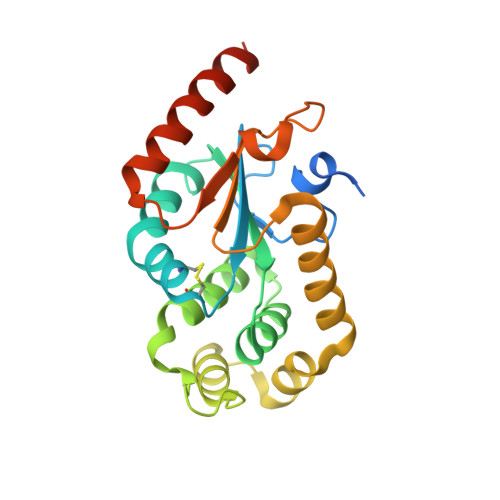Structural and Functional Characterization of the Oxidoreductase alpha-DsbA1 from Wolbachia pipientis
Kurz, M., Iturbe-Ormaetxe, I., Jarrott, R., Shouldice, S.R., Wouters, M.A., Frei, P., Glockshuber, R., O'Neill, S.L., Heras, B., Martin, J.L.(2009) Antioxid Redox Signal 11: 1485-1500
- PubMed: 19265485
- DOI: https://doi.org/10.1089/ars.2008.2420
- Primary Citation of Related Structures:
3F4R, 3F4S, 3F4T - PubMed Abstract:
The alpha-proteobacterium Wolbachia pipientis is a highly successful intracellular endosymbiont of invertebrates that manipulates its host's reproductive biology to facilitate its own maternal transmission. The fastidious nature of Wolbachia and the lack of genetic transformation have hampered analysis of the molecular basis of these manipulations. Structure determination of key Wolbachia proteins will enable the development of inhibitors for chemical genetics studies. Wolbachia encodes a homologue (alpha-DsbA1) of the Escherichia coli dithiol oxidase enzyme EcDsbA, essential for the oxidative folding of many exported proteins. We found that the active-site cysteine pair of Wolbachia alpha-DsbA1 has the most reducing redox potential of any characterized DsbA. In addition, Wolbachia alpha-DsbA1 possesses a second disulfide that is highly conserved in alpha-proteobacterial DsbAs but not in other DsbAs. The alpha-DsbA1 structure lacks the characteristic hydrophobic features of EcDsbA, and the protein neither complements EcDsbA deletion mutants in E. coli nor interacts with EcDsbB, the redox partner of EcDsbA. The surface characteristics and redox profile of alpha-DsbA1 indicate that it probably plays a specialized oxidative folding role with a narrow substrate specificity. This first report of a Wolbachia protein structure provides the basis for future chemical genetics studies.
Organizational Affiliation:
Institute for Molecular Bioscience, University of New South Wales, Sydney, Australia.
















